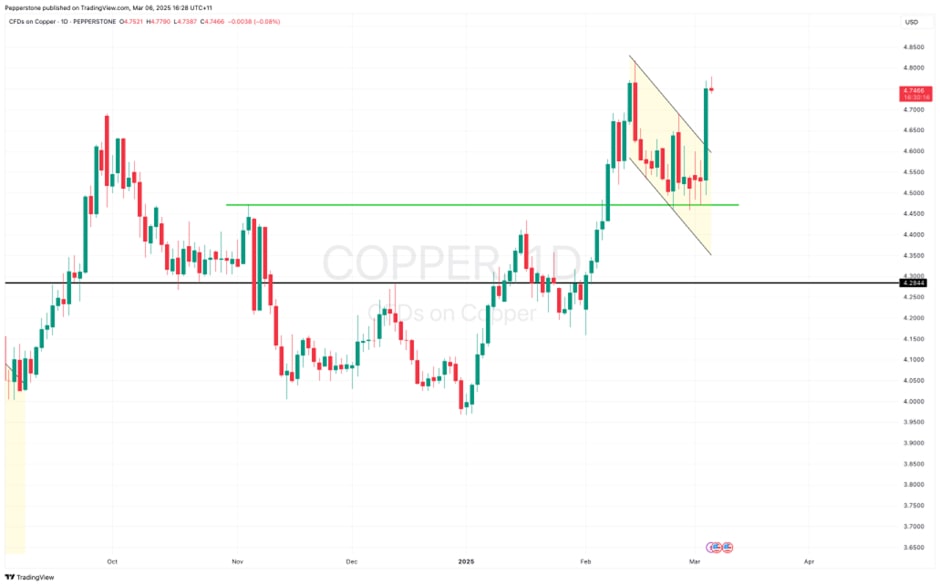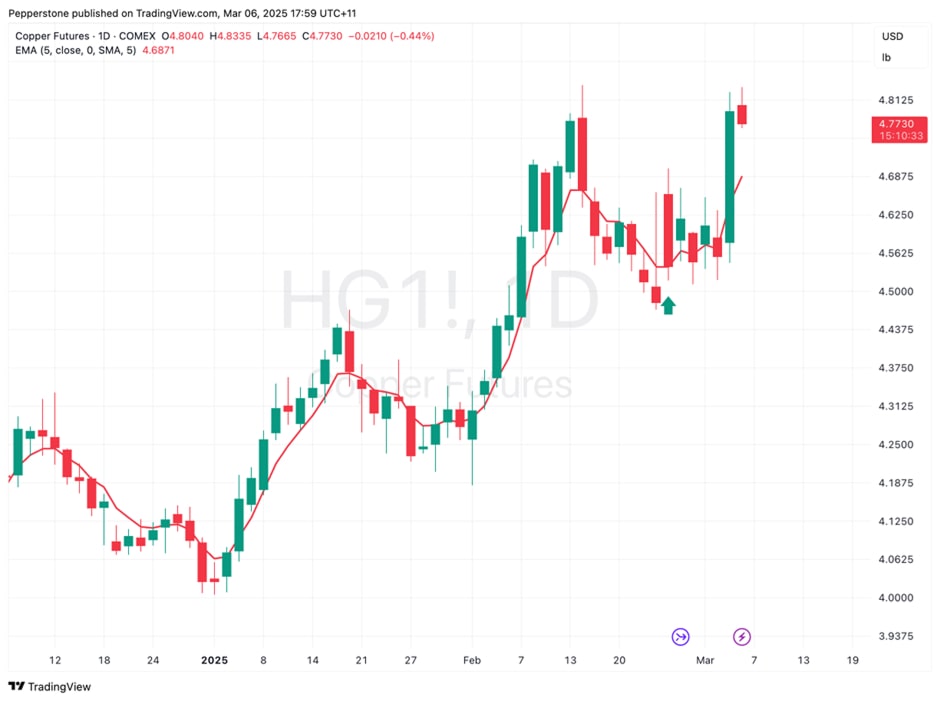- English
- Italiano
- Español
- Français
Global Copper Market: Volatility and Opportunities Amidst Multiple Forces
.jpg)
February Turbulence: The Tug-of-War Between Tariff Threats and Supply Disruptions

Following the early-year uptrend driven by U.S. economic resilience and rate-cut expectations, copper prices remained in a broadly bullish consolidation phase. By late February, two key events took center stage: shifting U.S. tariff policies and a sudden power outage at a major Chilean copper mine.
Trump’s wavering stance on tariffs for Canada and Mexico made market pricing increasingly difficult. His late-January hardline rhetoric sent copper prices lower, only to be reversed in early February when he announced a temporary suspension, triggering strong buying interest. However, on February 26, his executive order under Section 232 of the Trade Expansion Act to launch a national security investigation into copper imports reignited fears of escalating trade tensions.

That day, COMEX copper surged nearly 5%, and the price spread between LME and COMEX widened to $950 per ton, the highest since May 2024.
Simultaneously, a transmission failure in northern Chile caused production halts at Escondida—the world’s largest copper mine—along with several other sites. While this briefly fueled supply concerns, Chile’s power authorities announced a swift restoration within 48 hours. Combined with growing market fatigue over Section 232-related policy risks, copper prices quickly pared gains. Traders began recognizing that any potential tariff implementation would take time, leading sentiment to shift from panic to caution.
March Rally: Policy Expectations and Cross-Market Arbitrage
The copper rally on March 5 appeared driven by sudden catalysts, but underlying it was a confluence of policy shifts and capital flows.
On the demand side, China’s government work report set a 2025 GDP growth target of 5%, signaling stronger fiscal stimulus and a commitment to stabilizing the real estate sector. The report also emphasized consumer spending, tech sector support, and demographic policy adjustments. As a critical industrial metal and economic bellwether, copper benefitted from optimism surrounding China’s growth outlook, further amplified by AI-related investment themes.
Meanwhile, the persistently wide LME-COMEX spread became a focal point for speculative positioning. Since the U.S. launched its Section 232 investigation in late February, traders have increasingly bet on potential domestic supply shortfalls. If tariffs were imposed on key suppliers like Chile and Peru, U.S. smelters would struggle to offset the reduction in imports. This expectation prompted a surge in copper shipments from LME warehouses in Asia to the U.S., driving LME inventories lower while COMEX stockpiles climbed. Speculative funds capitalized on this trend, fueling COMEX copper’s rally, with algorithmic trading further amplifying the price surge.
Key Risks Ahead: Fragility in a Tightly Balanced Market
Uncertainty in U.S. Tariff Policy Implementation
The Section 232 investigation has a 270-day timeline, followed by a 90-day presidential decision window, creating a year-long policy risk horizon. Any shifts in government rhetoric could trigger sharp market moves. If tariffs of 10%-25% are ultimately imposed, South American miners may redirect shipments to Asia or Europe, while U.S. domestic copper prices would rise significantly above global levels. Such regional price distortions could reshape global copper trade flows in the long run.Questionable Strength of China’s Demand Recovery
Despite China’s pro-growth signals and a record-high State Grid investment plan exceeding ¥650 billion for 2025, challenges remain. The real estate sector remains a drag, with new construction starts down 23% year-over-year, while deflationary pressures persist. Without concrete stimulus measures post-NPC, elevated visible copper inventories (779,000 tons as of February) could cap price rebounds.Financial Market Volatility as a Potential Disruptor
A weaker U.S. dollar, driven by Fed rate-cut expectations, could support copper prices. However, stronger-than-expected U.S. economic data could revive rate hike concerns, putting pressure on copper. Additionally, the prolonged LME-COMEX spread divergence may trigger large-scale unwinding of arbitrage positions, exacerbating short-term volatility.
The global copper market remains a battleground of policy, industry fundamentals, and financial speculation. February’s volatility and March’s rally highlight the market’s struggle to navigate short-term noise versus long-term trends.
For now, China’s policy-driven demand narrative and the U.S. tariff-driven supply risk continue to define market sentiment. In the short term, traders must contend with high inventory levels and policy uncertainty. In the long run, structural demand from the green energy transition, supply constraints, and macroeconomic unpredictability ensure that copper will remain the “metal of contradictions.”
The material provided here has not been prepared in accordance with legal requirements designed to promote the independence of investment research and as such is considered to be a marketing communication. Whilst it is not subject to any prohibition on dealing ahead of the dissemination of investment research we will not seek to take any advantage before providing it to our clients.
Pepperstone doesn’t represent that the material provided here is accurate, current or complete, and therefore shouldn’t be relied upon as such. The information, whether from a third party or not, isn’t to be considered as a recommendation; or an offer to buy or sell; or the solicitation of an offer to buy or sell any security, financial product or instrument; or to participate in any particular trading strategy. It does not take into account readers’ financial situation or investment objectives. We advise any readers of this content to seek their own advice. Without the approval of Pepperstone, reproduction or redistribution of this information isn’t permitted.